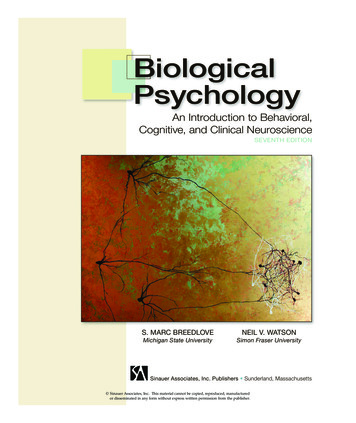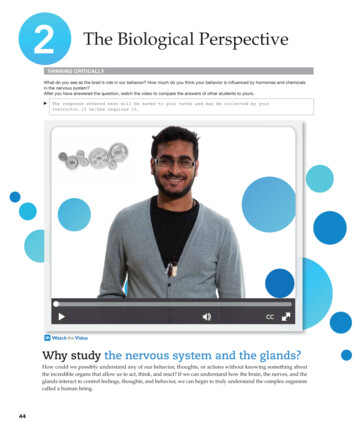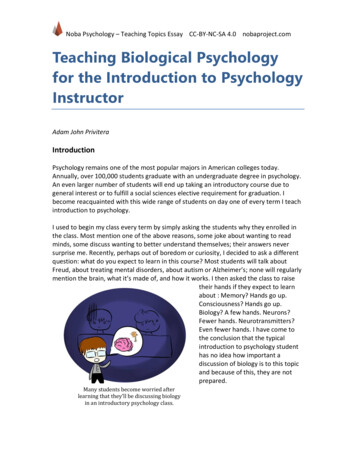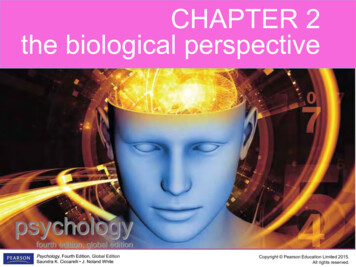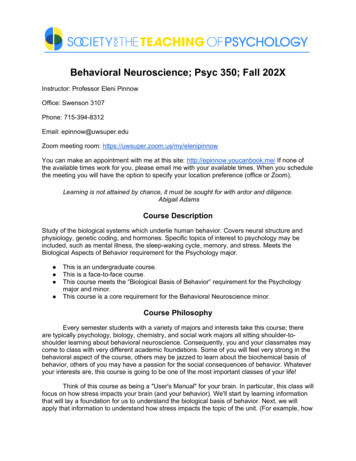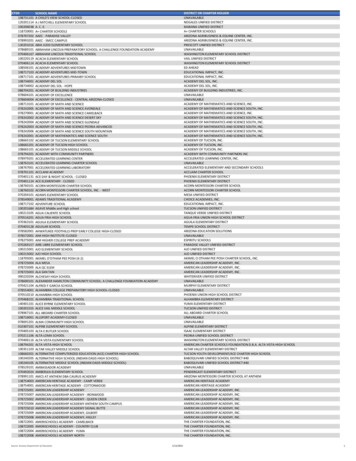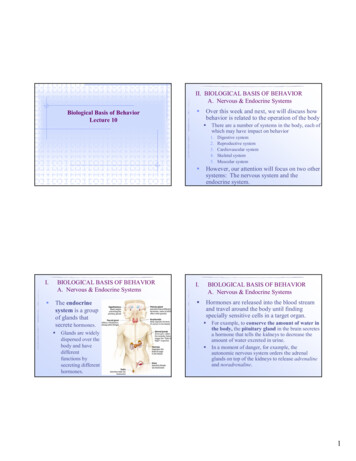
Transcription
II. BIOLOGICAL BASIS OF BEHAVIORA. Nervous & Endocrine SystemsBiological Basis of BehaviorLecture 10 Over this week and next, we will discuss howbehavior is related to the operation of the body There are a number of systems in the body, each ofwhich may have impact on behavior1.2.3.4.5. I. BIOLOGICAL BASIS OF BEHAVIORA. Nervous & Endocrine SystemsThe endocrinesystem is a groupof glands thatsecrete hormones. Glands are widelydispersed over thebody and havedifferentfunctions bysecreting differenthormones.However, our attention will focus on two othersystems: The nervous system and theendocrine system.I. Digestive systemReproductive systemCardiovascular systemSkeletal systemMuscular systemBIOLOGICAL BASIS OF BEHAVIORA. Nervous & Endocrine SystemsHormones are released into the blood streamand travel around the body until findingspecially sensitive cells in a target organ. For example, to conserve the amount of water inthe body, the pituitary gland in the brain secretesa hormone that tells the kidneys to decrease theamount of water excreted in urine.In a moment of danger, for example, theautonomic nervous system orders the adrenalglands on top of the kidneys to release adrenalineand noradrenaline.1
I.I.BIOLOGICAL BASIS OF BEHAVIORA. Nervous & Endocrine SystemsAnteriorPituitaryMaster gland which triggers hormone secretion in otherendocrine glands. Also releases Growth Hormone (GH)PosteriorPituitaryReleases vasopressin, which prevents water loss throughkidney.PinealMelatonin: Promotes sleeps and regulates biological clocks.ThyroidThyroxine (T4) and Triiodothyronine (T3): Affects metabolicratePancreasInsulin and Glucagon: Affects utilization of glucoseAdrenalCortisol: Increases sugar output.Adrenalin: Arouses various internal organs (heart, lungs)Overies(females)Estrogen: Produces female sex characteristics.Progesterone: Prepares uterus for embryo implantation.Testes(male)Testosterone: Produces male sex characteristics relevant tosexual arousal and related to aggression.BIOLOGICAL BASIS OF BEHAVIORB. Categorization of the Nervous SystemI. BIOLOGICAL BASIS OF BEHAVIORA. Nervous & Endocrine SystemsThe nervous system is a coordinatingmechanism in all multi-cellular animals,except sponges, that regulates internal bodyfunctions and responses to external stimuli. I. The coordinating activity is achieved by a group ofspecialized cells which are distributed throughoutthe body and communicate chemicallyBoth the nervous and endocrine systems eachcommunicates chemically but the nervous systemcommunicates locally, whereas the EndocrineSystem communicates long-distance.BIOLOGICAL BASIS OF BEHAVIORB. Categorization of the Nervous SystemThe nervous system can be categorizedseparate divisionsCentral Nervous System: The brain andspinal cordPeripheral Nervous System: Conveys (a)sensory information (e.g., pain, pressure) tothe Central Nervous System and (b) messagesfrom the Central Nervous System to musclesand glands.2
I. BIOLOGICAL BASIS OF BEHAVIORB. Categorization of the Nervous SystemPeripheral Nervous System: I. Peripheral Nervous System:The Autonomic Nervous System Parasympathetic Division of ANS: Involved inactivity associated with increases in the body’s supplyof stored energy. These activities include salivation, gastric and intestinalmotility, secretion of digestive juices, increased blood flow tothe gastrointestinal system, and inhibits heart rate.Think of what happens when you eat too much onThanksgiving. All you want to do is nothing while your body transforms thefood to stored energy (fat).BIOLOGICAL BASIS OF BEHAVIORB. Categorization of the Nervous SystemPeripheral Nervous System: The Somatic Nervous System: Receives sensoryinformation from the sensory organs and controlsmovements of the skeletal muscles for voluntaryand involuntary behavior.The Autonomic Nervous System: The regulationof the smooth muscles, cardiac muscle and glands.The function of the Autonomic Nervous System isthe regulation of “vegetative processes” in thebody. The ANS regulates life-supportingprocesses as digestion, heart rate, and respirationwithout requiring conscious control (which is areally, really good thing).BIOLOGICAL BASIS OF BEHAVIORB. Categorization of the Nervous System I.The Autonomic Nervous System Sympathetic Division of ANS: Involved in activityassociated with the expenditure of energy from reservesstored in the body. Think about telling a lie about which you are nervous. Nervous liars increase in heart rate, respiration, pupil size.Lie Detectors (Polygraphs) work on the same principle. I.When the organism is excited or stressed, the SympatheticNervous System increases blood flow to skeletal muscles,increases heart rate, and causes piloerection (erection of fur inanimals or goose bumps).They actually measure GSR (galvanic skin response whichassesses skin conductivity).BIOLOGICAL BASIS OF BEHAVIORB. Categorization of the Nervous SystemThe autonomic nervoussystem is a dual system:The sympatheticnervous system expendsenergy while theparasympatheticnervous systemconserves energy. Ineveryday situations, thetwo systems worktogether to keep us in asteady internal state.3
I. BIOLOGICAL BASIS OF BEHAVIORB. Cells of the Nervous SystemThe nervous system operates by thecommunication between trillions of cells andthe integration of communicated information.There are two general classes of cells in thenervous system: Neurons (nerve cells) andglial (nerve glue) support cells. I. We used to believed that absolutely noneurons regenerated or reproduced, but it turnsout that there are some exceptions to this rule. Precursor Cells (stem cells) can reproduce.Neurons in the spinal cord may regenerate iftreated chemically.Neurons in particular parts of the brain(hippocampus) may reproduce.However, we know from stoke victims, mostneurons will not reproduce or regenerate whendamaged. Why?BIOLOGICAL BASIS OF BEHAVIORB. Cells of the Nervous Systemi. Regeneration and growth Neurons are unique in that after a certain point indevelopment, virtually all neurons do notreproduce (multiply) or regenerate (grow).Unlike, skin cells, generally neurons do not growback when lost. Neurons and glial cells are like other cells in thebody but have specialized functionsWe will consider neurons first and then discussglial cells.BIOLOGICAL BASIS OF BEHAVIORB. Cells of the Nervous System I. I. In mammals, just after birth, much of the process ofneuron cell reproduction just stops. The number ofneurons at birth in some brain regions may be higherthan later in life because some neurons die.Thus, in contrast to other cells, at a point afterbirth, MOST neurons will never divide again andno new neurons are formed.BIOLOGICAL BASIS OF BEHAVIORB. Cells of the Nervous SystemNeurons do not reproduce or regeneratebecause the connections between cells is thebasis for learning. When you learn about psychology, what you learnis encoded at the cellular level in the form newconnections between neurons (not new neurons).If new neurons spontaneously grew overnight,then the connections you made between neuronswhen learning psychology may be lost.So to preserve the pattern of connections betweenneurons over time, neurons are specialized not toreproduce or regenerate.4
I.BIOLOGICAL BASIS OF BEHAVIORB. Cells of the Nervous SystemI.BIOLOGICAL BASIS OF BEHAVIORB. Cells of the Nervous Systemii. Neuron structureiii. Neuron typesDendrite: Branches thatreceive signals andtransmit to cell bodyCell Body: Controls cellmetabolism anddetermines firing.Axon: Carries impulsesaway from cell body tothe terminal endings.Myelin Sheath: Fattyinsulation surroundingthe axon and creatingnodes between themNeurons vary in size and shape,depending on their locationand function.Motor Neurons -- Axons connectwith muscles fibers or glandcells. They have an extensivedendrite tree, and a long axonSensory Neurons -- Conveysignals from the environmentto the nervous system.Inter-neurons -- Communicatebetween neurons and come ina variety of shapes and sizes.Often short axons or axons.I. BIOLOGICAL BASIS OF BEHAVIORB. Cells of the Nervous System Glial Cells I.1011BIOLOGICAL BASIS OF BEHAVIORB. Cells of the Nervous Systemi. Blood-Brain Barrier.There areneurons (100,000,000,000) but thenervous system contains many more glial cells.Glial cells do not conduct or transmit information. They provide structural support for neurons and haveother functions as well. Glial cells form a barrier between the blood streamand the brain, preventing the penetration into thebrain of substances in the blood.The blood-brain barrier is porous, allowing somesubstances, like hormones, to penetrateThey take up substances in the brain that are present in excessand are unneededGlial cells (unlike neurons) multiply to clean up and replacedead neuronsTwo other functions: They establish the blood-brainbarrier and the form myelin which coats axons.5
I. BIOLOGICAL BASIS OF BEHAVIORB. Cells of the Nervous Systemii. Myelin Myelin is a sheath of fatty material that wrapsaround (like layers of an onion) and insulates theaxon. Myelin functions to speed of conduction of theelectrical current necessary for neuralcommunication. Speed matters in the effective processing ofinformation Anyone go from an old computer to a new onewith a more powerful chip? What changesoccurred?I. BIOLOGICAL BASIS OF BEHAVIORB. Cells of the Nervous SystemBabies born with unmyelinized axons which,in part, explains their slow and uncoordinatedactions Myelinization may take place over years andcontinues from childhood into adulthood.Connection between sites where myelinizationoccurs and behavior during development. Birth to 3.4 - 4.5 years: Myelinization occurs in thebrain region where speech is processed and understood:Associated with more language developmentLater cycle occurs in the region of the brain wherecognitive functioning is central: Associated withquicker more complex reasoning.6
Biological Basis of Behavior Lecture 10 II. BIOLOGICAL BASIS OF BEHAVIOR A. Nervous & Endocrine Systems Over this week and next, we will discuss how behavior is related to the operation of the body There are a number of systems in the body, each of which may have impact on behavior 1. Dige
